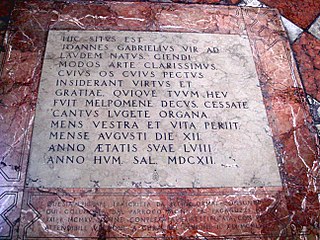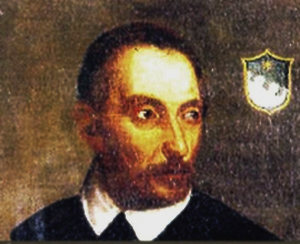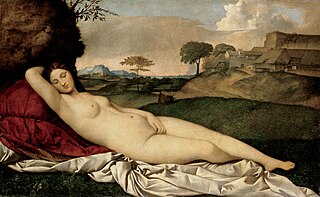History
Several major factors came together to create the Venetian School. The first was political: after the death of Pope Leo X in 1521 and the Sack of Rome in 1527, the long dominant musical establishment in Rome was eclipsed: many musicians either moved elsewhere or chose not to go to Rome, and Venice was one of several places to have an environment conducive to creativity. [1]
Another factor, possibly the most important, was the existence of the splendid St Mark's Basilica, with its unique interior with opposing choir lofts. Because of the spacious architecture of this basilica, it was necessary to develop a musical style which exploited the sound-delay to advantage, rather than fight against it: thus the Venetian polychoral style was developed, the grand antiphonal style in which groups of singers and instruments played sometimes in opposition, and sometimes together, united by the sound of the organ. The first composer to make this effect famous was Adrian Willaert, who became maestro di cappella of St. Mark's in 1527, and remained in the position until his death in 1562. Gioseffo Zarlino, one of the most influential writers on music of the age, called Willaert "the new Pythagoras", and Willaert's influence was profound, not only as a composer but as a teacher, since most of the Venetians who followed studied with him.
Yet another factor which promoted the rich period of musical creativity was printing. In the early 16th century, Venice, prosperous and stable, had become an important center of music publishing; composers came from all parts of Europe to benefit from the new technology, which then was only a few decades old. Composers from northern Europe—especially Flanders and France—were already renowned as the most skilled composers in Europe, and many of them came to Venice. The international flavor of musical society in the city was to linger into the 17th century.
In the 1560s, two distinct groups developed within the Venetian school: a progressive group led by Baldassare Donato, and a conservative group led by Zarlino, who was then maestro di cappella. Friction between the two groups came to a head in 1569 with a dramatic, public conflict between Donato and Zarlino during the Feast of Saint Mark. Members of the conservative branch tended to follow the style of Franco-Flemish polyphony, and included Cipriano de Rore, Zarlino, and Claudio Merulo; members of the progressive group included Donato, Giovanni Croce, and later Andrea and Giovanni Gabrieli. An additional point of contention between the two groups was whether or not Venetians—or at least Italians—should be given the top job of maestro di cappella at St. Mark's. Eventually the group favoring local talent prevailed, ending the dominance of foreign musicians in Venice; in 1603, Giovanni Croce was appointed to the job, followed by Giulio Cesare Martinengo in 1609.
The peak of development of the Venetian School was in the 1580s, when Andrea and Giovanni Gabrieli composed enormous works for multiple choirs, groups of brass, string instruments and organ. These works are the first to include dynamics, and are among the first to include specific instructions for ensemble instrumentation. Organists working at the same time included Claudio Merulo and Girolamo Diruta; they began to define an instrumental style and technique which moved to northern Europe in the succeeding generations, culminating in the works of Sweelinck, Buxtehude, and eventually J.S. Bach.
The term Venetian School is sometimes used to distinguish it from the contemporary, and usually more musically conservative, Roman School. Other important centers of musical activity in Italy at the same time included Florence (the birthplace of opera), Ferrara, Naples, Padua, Mantua, and Milan.

Giovanni Gabrieli was an Italian composer and organist. He was one of the most influential musicians of his time, and represents the culmination of the style of the Venetian School, at the time of the shift from Renaissance to Baroque idioms.

Adrian Willaert was a Flemish composer of High Renaissance music. Mainly active in Italy, he was the founder of the Venetian School. He was one of the most representative members of the generation of northern composers who moved to Italy and transplanted the polyphonic Franco-Flemish style there.

Orazio Vecchi was an Italian composer of the late Renaissance. He is most famous for his madrigal comedies, particularly L'Amfiparnaso.

Gioseffo Zarlino was an Italian music theorist and composer of the Renaissance. He made a large contribution to the theory of counterpoint as well as to musical tuning.

The Venetian polychoral style was a type of music of the late Renaissance and early Baroque eras which involved spatially separate choirs singing in alternation. It represented a major stylistic shift from the prevailing polyphonic writing of the middle Renaissance, and was one of the major stylistic developments which led directly to the formation of what is now known as the Baroque style. A commonly encountered term for the separated choirs is chori spezzati—literally, "broken choruses" as they were called, added the element of spatial contrast to Venetian music. These included the echo device, so important in the entire baroque tradition; the alternation of two contrasting bodies of sound, such as chorus against chorus, single line versus a full choir, solo voice opposing full choir, instruments pitted against voices and contrasting instrumental groups; the alternation of high and low voices; soft level of sound alternated with a loud one; the fragmentary versus the continuous; and blocked chords contrasting with flowing counterpoint.
Girolamo Diruta was an Italian organist, music theorist, and composer. He was famous as a teacher, for his treatise Il Transilvano on counterpoint, and for his part in the development of keyboard technique, particularly on the organ. He was born in Deruta, near Perugia.

Costanzo Porta was an Italian composer of the Renaissance, and a representative of what is known today as the Venetian School. He was highly praised throughout his life both as a composer and a teacher, and had a reputation especially as an expert contrapuntist.

Claudio Merulo was an Italian composer, publisher and organist of the late Renaissance period, most famous for his innovative keyboard music and his ensemble music composed in the Venetian polychoral style. He was born in Correggio and died in Parma. Born Claudio Merlotti, he Latinised his surname when he became famous in Venetian cultural clubs.
Girolamo Dalla Casa, also known as Hieronymo de Udene, was an Italian composer, instrumentalist, and writer of the late Renaissance. He was a member of the Venetian School, and more influential as a performer than as a composer.
Baldassare Donato was an Italian composer and singer of the Venetian school of the late Renaissance. He was maestro di cappella of the prestigious St. Mark's Basilica at the end of the 16th century, and was an important figure in the development of Italian light secular music, especially the villanella.
Giovanni Croce was an Italian composer of the late Renaissance, of the Venetian School. He was particularly prominent as a madrigalist, one of the few among the Venetians other than Monteverdi and Andrea Gabrieli.
Gioseffo Guami was an Italian composer, organist, violinist and singer of the late Renaissance Venetian School. He was a prolific composer of madrigals and instrumental music, and was renowned as one of the finest organists in Italy in the late 16th century; he was also the principal teacher of Adriano Banchieri.
Giulio Cesare Martinengo was an Italian composer and teacher of the late Renaissance and early Baroque Venetian School. He was the predecessor to Claudio Monteverdi at San Marco.
Ippolito Chamaterò was an Italian composer of the late Renaissance, originally from Rome but active in northern Italy. He wrote both sacred and secular music, particularly madrigals; all of his surviving music is vocal. His sacred musical style was in conformance with the Counter-Reformation musical ideals following the Council of Trent, and his madrigals were related stylistically to those of Adrian Willaert and Cipriano de Rore.
Oltremontani were those of the Franco-Flemish School of composers who dominated the musical landscape of Northern Italy during the middle of the sixteenth Century. The role of the oltremontani composers at the ducal courts of Italy was analogous to the dominance at the Spanish court of the Flemish chapel, and other composers of the Franco-Flemish School in Germany and France.
The Cappella Marciana is the modern name for the choir and instrumentalists of St Mark's Basilica, Venice, Italy.
Ippolito Baccusi was an Italian composer of the late Renaissance, active in northern Italy, including Venice, Mantua, and Verona. A member of the Venetian School of composers, he had a strong reputation as a master of counterpoint, and wrote both sacred and secular vocal music.

The Venetian Renaissance had a distinct character compared to the general Italian Renaissance elsewhere. The Republic of Venice was topographically distinct from the rest of the city-states of Renaissance Italy as a result of their geographic location, which isolated the city politically, economically and culturally, allowing the city the leisure to pursue the pleasures of art. The influence of Venetian art did not cease at the end of the Renaissance period. Its practices persisted through the works of art critics and artists proliferating its prominence around Europe to the 19th century.








